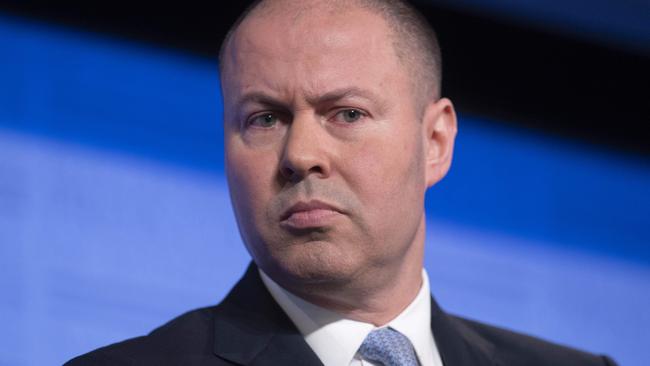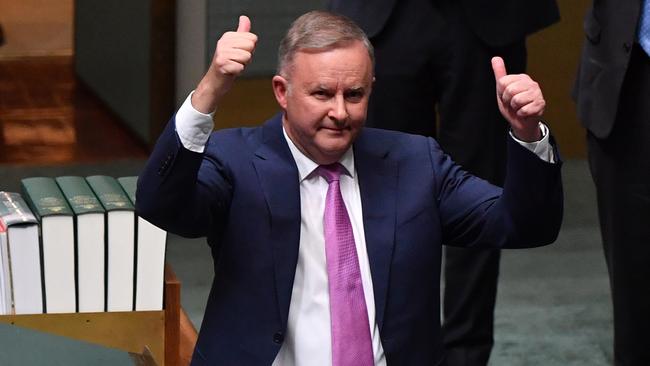Terry McCrann: Lack of restraint in budget spending a danger
Anthony Albanese’s team must have been burning the midnight oil – or running those Labor Party windmills at warp-speed – to find something that Frydenberg missed in the budget, because our treasurer sure spent money like there was no tomorrow.
Terry McCrann
Don't miss out on the headlines from Terry McCrann. Followed categories will be added to My News.
The most surprising feature of budget week came on Thursday night – opposition leader Anthony Albanese was actually able to identify some areas that had missed out on being sprayed with cash by treasurer Josh Frydenberg on Tuesday night.
Albanese zeroed in on childcare, promising to spend at least $6bn to make it all but free for families with incomes up to $85,000 and even giving some money to people with incomes all the way up to $530,000.
He also promised to build more trains in Australia, but stopped short of committing also to planes and automobiles – sorry, Steve.
He and his team must have been burning the midnight oil – or running those Labor Party windmills at warp-speed – to find something that Frydenberg had missed, because our treasurer sure was spending money like there was no tomorrow, or at least, that you could borrow it all-but interest free.
Frydenberg’s second budget outdid all other budgets in Australian fiscal history in the amount of spending — $677bn this year, or $26,000 for every single Australian and double what Swan had spent in 2009-10.
It outdid all other budgets in its share of the total economy – 35 per cent as against the previous highest (excluding Frydenberg’s ‘warm-up’ last year) 27.7 per cent. And, no, that was not Swan but (Paul) Keating’s 1984 budget.

And it blitzed the rate of real spending increase – with spending leaping a thumping 22.6 per cent in real terms, outpacing even the 19.9 per cent leap in (Gough) Whitlam’s infamous 1974 budget that had stood unchallenged (even by Swan) for nearly half a century.
Frydenberg’s cash splash wasn’t only on the spending side of course. He cut taxes by $12bn this year ($32bn next year) – with the biggest item the bringing forward of the already legislated personal tax cuts.
So all this ‘added up’ to the biggest deficit we’ve even seen – $214 billion, or some four times Wayne Swan’s previous record $54 deficit back in 2009-10.
That’s to say, what was the biggest deficit before the $85bn of red ink in Frydenberg’s ‘warm-up’ first budget in the 2019-20 year.
Our treasurer also set the country on the path to deficits stretching every year into the future as far as the fiscal eye can see — and indeed even further than that.
Our net government debt will hit $1 trillion before we get half-way through the 2020s, will go past $1.5 trillion before we exit the 2020s, and just keep rising into the never-never.
Right now it is almost literally free money. The government can borrow – from global investors and from our super funds and indeed increasingly from the Reserve Bank itself (printing money) – at 1-2 per cent rates of interest.
But those low rates cannot last forever. You have to pay savers some sort of return or else they will basically stop saving – or pour the money into property and shares or simply just spend it.
At the moment rates are low – everywhere – for two connecting reasons.
The mammoth liquidity – tens of trillions of dollars sloshing around the world, in significant part ‘printed’ by the big central banks of the US, Europe and Japan, looking for a place to invest.

Much of that money has gone into shares and property; but much of it is looking for safety and that safety is seen as government bonds – even the bonds of countries like Greece and Italy, which even just a few years ago had to pay interest rates of 20 per cent and more to attract money.
In short, governments are gorging on the ‘free lunch’ of cheap debt and our governments – governments, plural actually, including the states – have joined in.
But it cannot last and if indeed it did we would probably have an even bigger problem as it would mean our economy and the world economy remained mired in deep recession if not near-depression.
So if we hopefully get back to ‘normality’ we’ll still have the debt and instead of it costing the budget something like $20-30bn in interest every year, it’ll start costing more like $40-60bn every year and then $60-80bn every year, and then…….
What Frydenberg’s budget started and Albanese’s response confirmed was that the fundamental rule of budget restraint has been abandoned – and that takes us into very dangerous territory.
If you don’t have to at least pretend to, if not actually try to, ‘balance the budget books’, what’s another billion or ten in a ‘good cause’?
Albanese zeroed in on child care. He could just as well have promised to subsidise businesses giving jobs to people aged over 35, as the budget did for people under 35.
Yes, much of the spending is supposed to be temporary because of the virus lockdowns. But it is all too easy to make much of it permanent.

